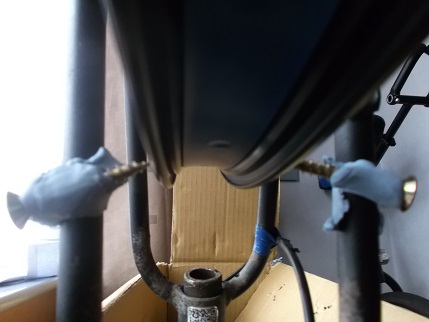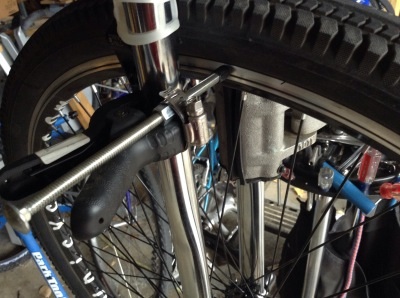Well, I’m ganna be buying a new rim/tire, and plan on Praying I don’t “F” it up, and build my own wheel. But I’d like to maybe get some recomendations on a truing stand, I don’t want to buy one then regret it later, I want something thats small/foldable. Since I move often, and I don’t like stuff that takes up alot of space, I also don’t want to buy a dishing stick or whatever, So i’d like to to be one of the self centering ones…? I don’t know much about them. But i’ve seen some that say they are self centered so you don’t need a dishing stick.
Re: Truing stand recomendations
Use your frame as a truing stand. Immobilize it somehow. Then spin the wheel and voila!
as with most things, you get what you pay for. i’d go park tools.
Like the OB1 said - use your frame. Its free!
Well i’d still need a dish stick then.
Au contraire, true your wheel so that it centers between the frame and you’ll be all set. Tie wraps on the forks make great guides.
I’ve built 3 wheels using my frames, it works. Don’t waste your money on other stuff. Also, a dushing stick won’t even work on a 19" wheel, and it barely works on a 24. Just stick with your frame and a good vise with wood blocks to support the seattube.
Re: Truing stand recomendations
“One on one” <One.on.one@NoEmail.Message.Poster.at.Unicyclist.com> writes:
> Au contraire, true your wheel so that it centers between the frame and
> you’ll be all set. Tie wraps on the forks make great guides.
That assumes your frame is true.
I find that building wheels with zero dish is usually sufficient.
Start by installing the nipples just to the end of the spoke threads,
then turn them the same number of turns to lightly tension the wheel.
Use appropriate turns while truing and tensioning to keep the dish
centered.
As for truing stands, I have one but I don’t use it for building
unicycle wheels. A uni wheel won’t spin properly in a bicycle truing
stand (at least not the one I have). A piece of tape with the end
folded to a point can be attached to the frame for truing, though to
be honest I’ve had good results simply holding my thumb on the frame
and spinning the wheel. If you really want to get precise, you can
attach a dial gauge to the frame like I did in this thread:
http://unicyclist.com/forums/showthread.php?s=d745b541334ddd64a0de2f48613f5398&threadid=32142&highlight=allthread
Ken
I’ve built 2 wheels now, one in the frame and another in a truing stand I bought.
I went with Performance bike’s Spin Dr. I think it’s well worth spending the $70. For me it was a lot easier truing on the stand than the frame.
I considered the Park tools stand, but couldn’t justify the expense since I’m only truing a few wheels a year, most likely. Yeah the Spin Dr. feelers are pretty cheap, but they work fine and allow accurate enough truing.
I’d say if you are really going to get into wheel building and are building or truing more than a few wheels a year and you have the bucks, get the TS2x, otherwise a cheaper truing stand is a happy medium.
built 4 wheels here. i have a Tacx T3175 Exact Wheel Truing Stand. worked ok on the first wheel build. all the rest i use the uni frame and never looked back!
measure up everything precise, hang tabs around the place off the frame forks, measuring rule never leaves my hand. spoke wrench in the other. after a couple wheels and getting spokes on the correct side of the rim its pretty easy. they have stayed true and no dings or buckles as yet!
Just please be sure to correctly tension spokes. i think that is most important as well as accurate truing. never balanced a wheel though. should we be considerate of a balanced wheel?
regards, D
trueing stand
don’t you need to buy unicycle bearing adapters to even true it in a stand?
Or you could use a weighted unicycle box for a stand then use two screws as trueing guides. The screws in the picture are held on with blue tak. The blue tak makes it easy to adjust the screws as trueing progresses.
I reckon that the screws are better than plastic ties because they’re much noisier, meaning that the slightest contact between wheel and screw will be very easy to detect

I’ve been building my wheels for fifteen years and I’ve never done anything but use the bike/uni frame as a stand, and my thumb as a gauge. If I were building wheels daily for a shop I’m sure I’d want a proper stand, but not for a handful of wheels a year.
I think my thumb is a lot more sensitive than a feeler gauge, anyway. I do have a dishing tool, but in the big picture, a mm or two off is going to be buried in the other “slop” - frame alignment, a big fat tire, your foot position on platform pedals, your butt position on a big seat with uneven foam…
Hello MrImpossiblle. I’ve tried using my thumb but it meant I was sensitive to only one side of the wheel at a time.
With the screws I can monitor both sides simultaneously and both of my hands are free. Also I find the screws very helpful for monitoring the horizontal trueness of the wheel as well as the vertical trueness.
Efficiency saves time and helps me to stay relaxed. It takes less than a minute to attach the screws and saves me so much time in the long run.
I have a truing stand, and I build a lot of wheels. When I’m building uni wheels I have mostly used a a uni frame to hold the wheel in a bike repair stand. I have a feeler that I made out of an A-clamp with a threaded coupler, and a long bolt. The clamp attaches to the frame, and I can screw the bolt in and out in very small increments. It is easily as precise as any truing stand I’ve used. When I get home I’ll take a photo of it. My regular truing stand is a work horse, but I rarely have felt the need or desire to use it on uni wheels.
If you are in the market for a truing stand I think you can do a lot better than a Park TS2. Honestly, I think a uni frame with a decent feeler is better. For what it’s worth I have a VAR Atomic stand, so it’s not like I’m just recommending the cheap option.
Really like the idea of the screws with blu-tac! Indeed, what’s nice about a stand is that it makes sound when it rubs. Which makes for an easier job.
Not sure a stand is required if you don’t build more than a wheel or two every year. But if you want to spend money on truing, then you should get a spoke tensionmeter. That is pretty neat and more precise that “feeling the tension”:
http://www.chainreactioncycles.com/us/en/s?q=park+tool+spoke+tension+meter+tm1
Truing feeler clamp
Here’s the clamp I use to true wheels on uni. Also, a lot of the bike wheels I true are done on bike with this clamp.

blutac and screws… wont the metal screws scratch the alloy rims???
Thumb method i have used this but i feel my thumb can be positioned slightly different each time without my knowing and its organic so it can change size…
cable ties, those spacers that go between brake pads when you get new hydros, even a rubber band over the forks and electrical tape as markers.
all can be adjusted and if setup well you can true wobbles, center and hop easily and quickly. with new spokes and parker tension tool my rims came together very well. easier than expected. I think i have my spokes on 22-24 on the parker tension. Rode months now maybe over a year on the rim. i used to check tensions but never adjusted one and its still true.
Anyone wanting to do a wheel build i say give it a go yourself. Bike shops here take forever and customer service when i had 2 wheels wasnt great. parts are expensive and having one wheel i dont think will change that much.
DIY for all Uni’s. Any info you will ever need is all in this forum!
I was thinking the same thing. I do like the audible feedback I get on my VAR stand. I may try to copy the feelers on that stand with my clamp in the future. The VAR has rubber ends on spring loaded pistons for the feelers. This sets up a harmonic vibration that is loud, plus it won’t ever scratch rims.
Zip ties work pretty well, but it’s hard to place them carefully. A toothpick or pencil with a rubber band works pretty well too, but again a little difficult to position carefully. It was these two methods that lead me to the clamp that I currently use. I find it much easier, quicker, and I can always repurpose the parts if I need to.